Chapter 6
Optimize for Relevance
A squirrel dying in front of your house may be more relevant to your interests right now than people dying in Africa.
—Mark Zuckerberg
Your prospects are animals. They hunt, forage, and consume just like their wild counterparts. Only today, they’re no longer roaming the savannah searching for wild deer or prairie shrews. They’re on their laptops, tablets, and phones hunting for information, entertainment, and consumables to buy.
Animals have evolved refined biological algorithms that constantly evaluate feedback from their environment to adjust their hunting paths. If the scent of their prey weakens on the path they’re following, they return to a previous location to find a stronger scent path. This algorithm has been refined to locate paths where the scent of their prey gradually increases. This is what we think of as the scent trail foraging behavior.
Your prospective customers use a similar mental algorithm when searching for the online information they need. They may be engaged in a focused search with a particular need in mind. Or they may have been interrupted by a message that triggered a desire response and began a hunt down a foraging path. Either way, once they’re on a hunt, they use primal foraging behavior to identify the information and products they need.
You can enable this hunting behavior in your marketing by providing the scent trail prospects are looking for. Your effectiveness at capturing and maintaining your prospects’ attention from interest through to purchase is, to a great extent, determined by your skill at creating a strong and encouraging information scent trail.
In this chapter, you’ll learn how to create that scent trail, called relevance, to gain more conversions, customers, and revenue. You’ll see, with examples, how to maximize these five areas:
- Relevance throughout the marketing funnel
- Relevance to the source media
- Relevance to the target audience
- Relevance for the competitive environment
- Relevance to the visitor’s navigation preferences
We begin by looking at how your website fits into your marketing funnel.
Marketing Funnel Relevance
Your marketing funnel begins long before your prospect arrives on your website, and your messages should maintain relevance throughout.
If you look from the perspective of your website, your landing page is the first point of contact with a prospect; but to your visitor, it’s just one step along a foraging path. The scent trail needs to maintain its strength to carry them to your desired action of becoming a lead or customer.
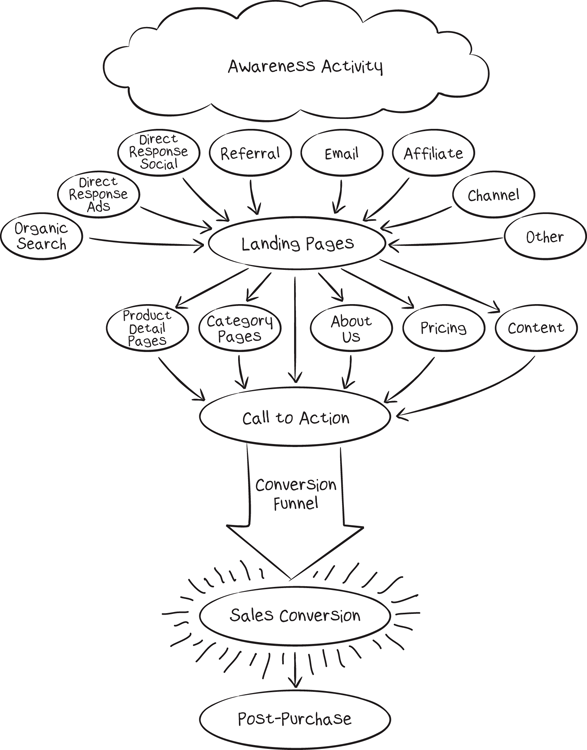
Your prospect’s funnel includes all of the touch points:
- Their original awareness of your brand and solution
- The action-promoting interception via an ad, email, social interaction, or other referral source
- Your landing page
- The exploration of your company, products, and services
- Your conversion transaction via email, online forms, phone calls, bricks and mortar, channel partners, or other response channel
- Your salespeople (for lead generation)
- The post-purchase experience
A consistent scent trail through all of these touch points can become a positive experience that creates brand equity. An inconsistent experience with reduced relevance creates dissonance, which can harm the brand and reduce conversions.
Source Relevance
The martial art of jiu-jitsu teaches fighters to use an opponent’s momentum rather than fight against their movements. It’s much easier and requires less strength to pull someone in the direction they’re moving rather than push them in a new direction. It’s the martial art of efficiency. Use minimal force for maximum effect.
Although clearly it’s counterproductive to view your prospects as opponents, you can still use jiu-jitsu’s principles of “unifying with the other” to create more effective marketing campaigns. By acknowledging and unifying with your prospects’ momentum, you can guide them to your conversion.
Visitors to your ad or website arrive from somewhere, and you can take that source medium into account to understand their intentions. They may have been searching for a product or service like yours or been interrupted while doing something unrelated. In either case, they were motivated by the ad’s message and responded to your call to action.
Once they’ve arrived and are viewing your message, you need to keep your visitors engaged and motivate them to move to the next step in your conversion funnel. What is the first thing you should say to them?
Some believe you should state all your benefits in your headline: “Save Time! Save Money! Satisfaction Guaranteed!” it would yell.
But that’s often ineffective. The first problem with such headlines is that their generic benefits are overused. So many products claim to save people time and money that those claims have lost their effect. You’re better off using your specific advantages.
The second problem is that the scent trail is lost. You need to satisfy the hunter’s scent trail before selling your benefits. Your prospect’s primal urge to follow the search scent is strong, and you should satisfy it first.
Relevance to Ad Messages
Ads that interrupt people are much less effective than ads with high relevance. This is why ads for relevant keywords on search engines get vastly higher click-throughs and conversions than ads on social media sites. When people are on a search engine, they’re in a frame of mind that looks for a solution. They’re looking to sniff out a scent trail to find their goal.
When they’re on Facebook, they’re looking for photos of their friends. They’re seeking entertainment and connection, not your product. In that mind frame, your ad is a nuisance!
Recently, I came across a video-review website in a search for a video-editing tool for an employee. What I found is a good example of both good and not-so-good relevance.
The ad, for a tool called PowerDirector 10, was highly relevant to the site and a typical visitor’s intention for being there. Most visitors to that site are looking for video-editing software to make movies. The ad’s message, “Make the Perfect Movie,” implied that the marketer had a clear understanding of the target audience’s needs.
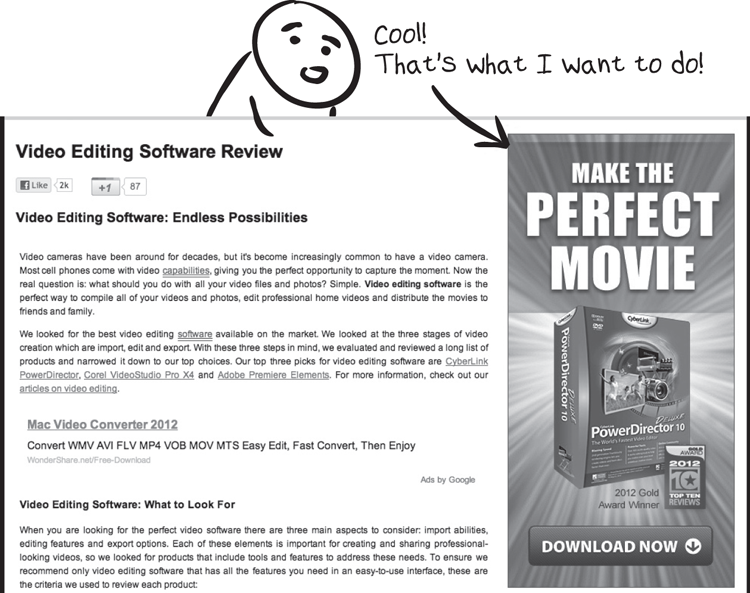
The ad’s bold design and clear value proposition caught my attention. I clicked the ad, interested to see how the site would pay off that promise. Unfortunately, the landing page was a disappointing disruption in the scent trail.
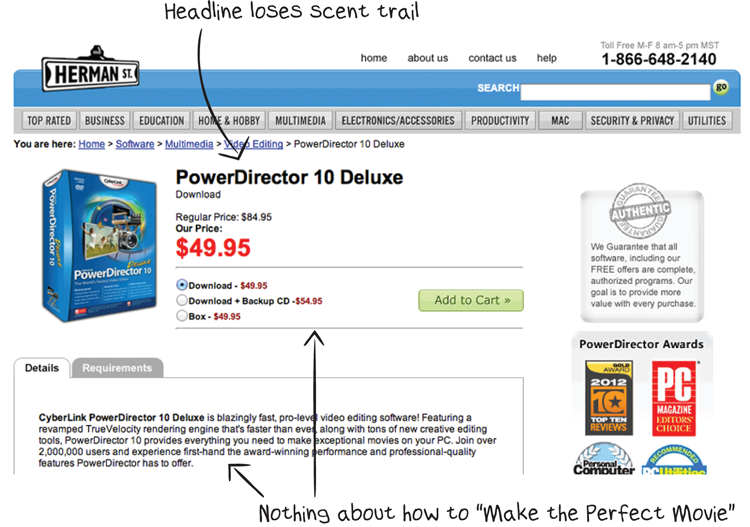
This landing page could have improved relevance with this headline:
“Make the Perfect Movie with PowerDirector 10 Deluxe”
I’d advise this advertiser: You Should Test That!
Then they should improve relevance even more by testing how the copywriting could fulfill that “Make the Perfect Movie” promise.
Once your prospects have shown enough interest to click your ad, your most prominent message in the following steps should match the ad message. Any message mismatch tells the visitor that they may have a weakened or lost scent trail and should return to the previous page or search engine.
Relevance to Search Keywords
Visitors who come to your website from search engines are in a better mindset for action than those from most other advertising media. Search-engine visitors are actively looking for a solution or information to solve their needs.
Your challenge is to give searchers the strong scent trail they need to continue through to your website and conversion funnel. The relevance of your ads and landing page to the keyword phrases is an important part of that relevance.
Synonyms Are Invisible
Your visitors may use different words to describe your product than you would, and you’ll create a more effective scent trail by using their language. If you offer “Legal Will & Testament Services,” your prospects may not use those words to find you. They’ll probably search for something like “create a will” or “make a will” or “download will template.”
It’s important to understand that even if what you say means the same thing as their search term, synonyms or similar phrases don’t maintain a scent trail. They can be as good as invisible to the searcher. The reason: the searcher isn’t processing all the words for understanding.
An example search for “create a will” shows that most ads have lost the scent trail before the prospect even clicks them.
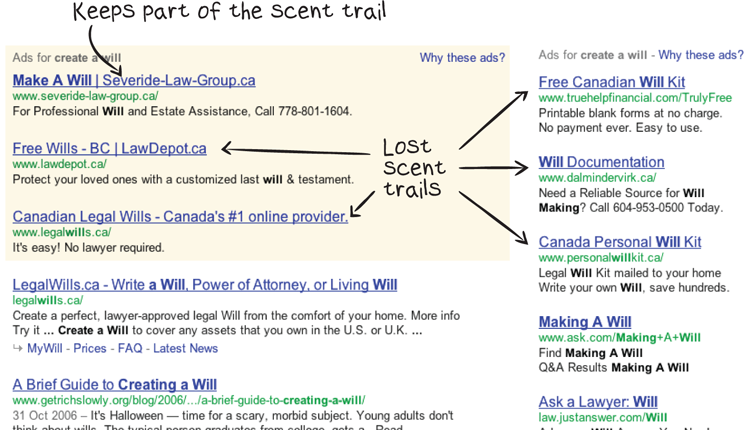
The most closely matched ad says “Make a Will,” which is at least 50 percent similar to “create a will,” so it’s doing better than the competition. You should carefully target your ads to match as closely as possible the search terms your prospects are using.
Unfortunately, the closest-matching ad’s landing page loses the plot.
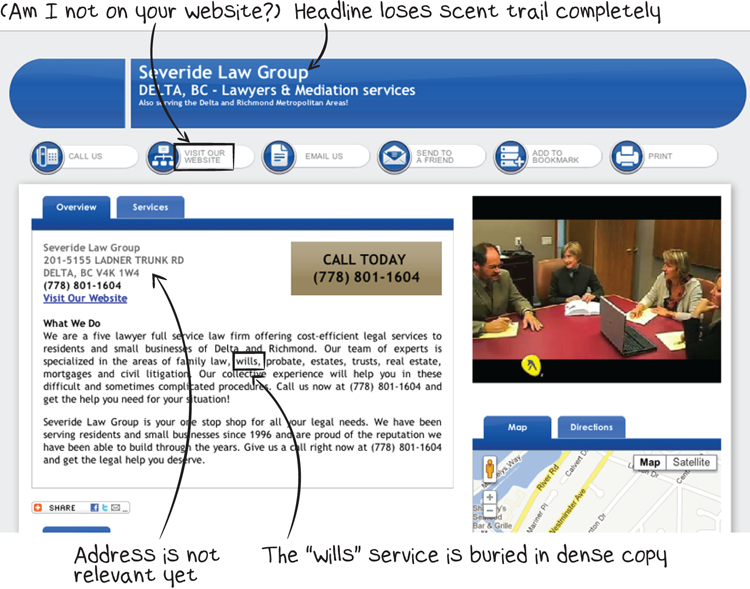
This company may employ excellent lawyers and probably provides a will-creation service that some prospects are looking for, but the scent trail is lost. Among other problems, this page has very low relevance to the words the prospect used for searching and the ad they clicked to get to the page.
This company seems to be using a generic overview page as a landing page. It wouldn’t take much effort to create a more relevant experience by at least directing ads to specific service pages.
This problem is common. At WiderFunnel, we see companies of all sizes that send much of their expensive traffic to their home page rather than relevant product pages or, even better, customized campaign landing pages. Creating relevant landing-page experiences doesn’t have to be burdensome, but it does take some planning.
If I were to help this firm improve its campaign conversion rate, at least one of the challenger test variations would focus on improving the relevance of the landing page.
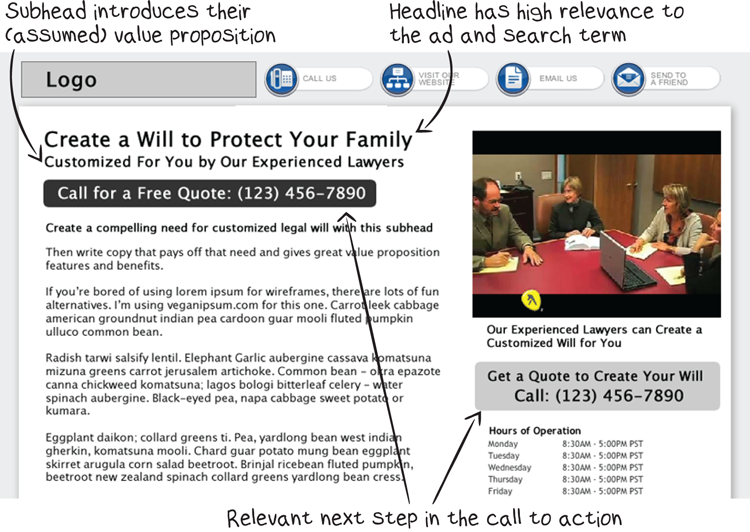
This new layout test includes several important changes that focus the content on the most relevant value-proposition statements. I’d recommend that the firm have a landing page like this for all the common services potential clients might search for, such as trusts, probate, and so on.
I would recommend testing more than just this one challenger against the control page, too. Testing only two pages at a time gives you some potential for learning and improvement, but it’s limited. This company could test plenty of other hypotheses to increase relevance. For example:
- Adding an image of a sample will document
- Adding an image of a typical customer
- Copy focused on the will-creation process
- A headline that speaks to the risks of not having a will
- Replacing the video with a will-specific message
- Adding social proof with testimonials of people who have had wills created
- And lots more!
A conversion champion who thinks from the perspective of the visitor will find many ways to test elements that increase relevance to the source media.
Pattern Matching
When people are in search mode, they switch from a processing mind frame to a pattern-matching mind frame. A processing mind frame takes significantly more time, energy, and mental bandwidth than pattern matching. A person on a search doesn’t have time for all that processing. They just need to find their goal as quickly as possible so they can move on to the next task.
To illustrate how this pattern-matching system works, imagine that you’re searching for a solution but you can’t understand the text because the site is written in a language you’re not familiar with. For example, let’s replace a set of search ads with words written in an Inuit dialect called Inuktitut, which is only used in the far Canadian north. (If you do understand Inuktitut, please bear with me for this analogy.)
Imagine that you’re looking for a solution to this phrase (translation: “Where’s the toilet?”):

You enter the search term into your Inuktitut search engine and see a set of ads that looks like this:

I’ll bet you found the most relevant ad to click pretty easily. You didn’t even need to understand the words to find the best result. You just used the pattern-matching mental process.
People’s brains are extraordinarily good at pattern matching, but it can become a liability in their search results. If a prospect searches for “create a will” they could miss a great solution just because it’s worded differently. An ad that says “Create a Will” has much higher relevance and is more likely to be clicked than another that says “Personalized Legal Contracts,” even though both ads could lead to the same type of service.
Dynamic Keyword Insertion
Search engines provide a feature called dynamic keyword insertion (DKI) to help automate the inclusion of keywords in ad text. You can use this feature to have a searcher’s search terms automatically inserted into your ads. A search for “leather wallets,” for example, shows the contrast in relevance between ads with keywords inserted and those without. Which do you think appear most relevant to a pattern-matching searcher?
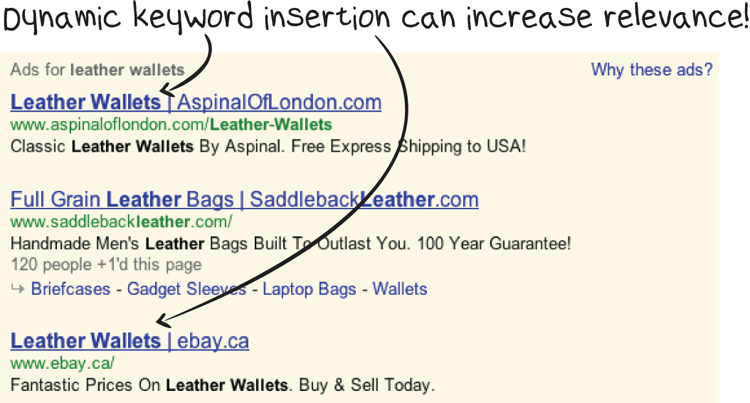
This automated keyword insertion can be useful for large search campaigns where manual customization is too time-consuming, but you also have to set up your campaign carefully to avoid inserting keywords that you can’t deliver on.

Or worse:

Whether you choose to use DKI or to manually set up relevant ads, you should make sure the relevant messages carry through to your landing pages.
Relevance to Emails
If relevance to ads and search is important, providing a relevant experience in your email campaigns is even more so. You know a lot more about members of your email database than about new website visitors; and with a little forethought, you can provide an awesomely customized experience.
For example, an email campaign from Banana Republic in mid-April created seasonal relevance by including a reference to tax season (although I would debate whether that creates a desirable brand connection).
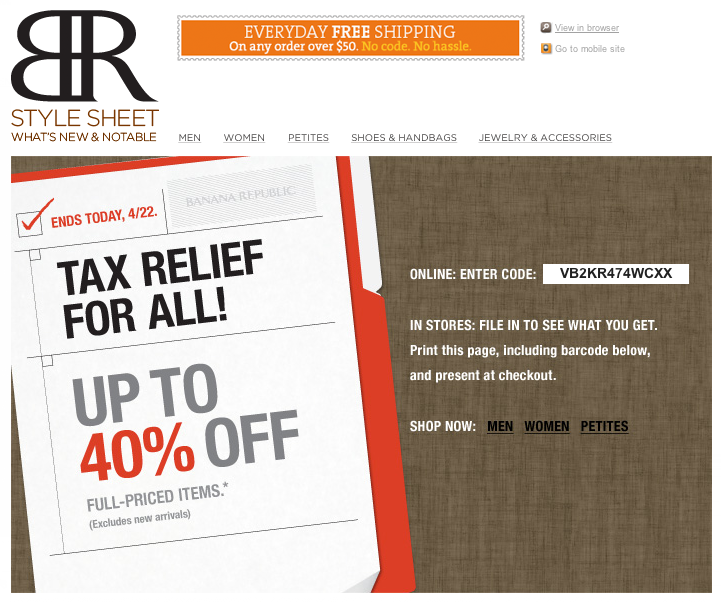
It could have been even made more relevant by customizing it to the recipient’s gender. The web page has the user’s purchase history and, assuming it has seen a pattern of women’s clothes purchases, could use that information to show more relevant imagery and emphasize the link to women’s clothes.
The 40 percent discount offer is compelling, though. The call to action isn’t prominent, but if the reader is in the market for new office wear, she may be motivated enough to put effort into finding the link.
She probably has questions that the email didn’t answer, such as which items are included and what the “Up To” part of the email headline means. Will this offer apply to the cute dress she’s had her eye on? Will she get the full 40 percent discount?
Unfortunately, once she clicks the link, relevance is lost.
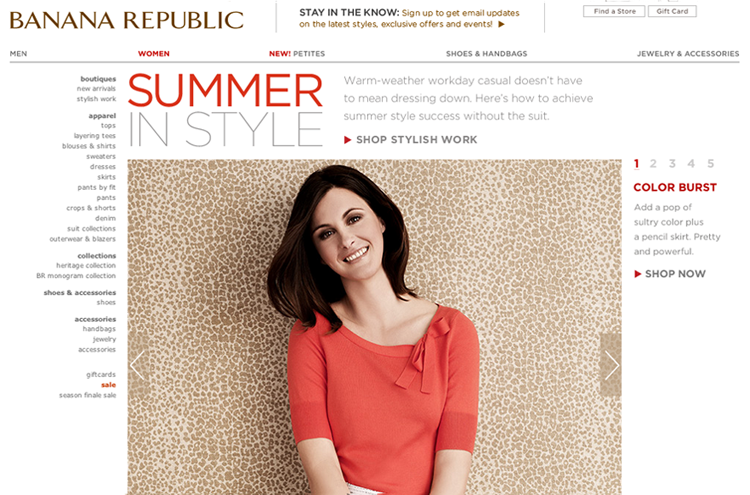
The landing page has no mention of the offer, the products the discount applies to, or the prospect’s unique discount code.
Even after clicking through to the product category page, she sees no sign of which products are included in the sale and what the discount rate is. The shopper may have some interest, but the effort of figuring out the offer and the confusion over the missing relevance has added an unnecessary barrier for her to overcome.
When creating offers, you should plan the entire experience for visitors. Don’t make them figure out how your offer works. Answer their questions when they’re thinking of them, and create a strong scent trail—they will reward you.
Three Ways to Create Landing-Page Source Relevance
To maximize landing-page relevance to your search advertising, you need to consider the keywords and ad copy. You can take three approaches—targeting, customization, and standardization:
If you have to choose between testing your overall value-proposition position and targeting, you should begin with overall message testing with the largest traffic group you can aggregate. Then, once you have refined your main messages, test the added benefit of message customization and targeting.
Target Audience Relevance
Great copywriters seek to understand the target audience before they write a single word. Great conversion champions do the same. Understanding your audience will help you answer important questions about your pages, like these:
- Do your messages meet your prospects’ needs?
- Does the page content match what they expect to see?
- Is your value proposition appealing to them?
- Are your calls to action appropriate for their buying behavior?
Without understanding your audience, you won’t be able to evaluate aspects like these, and your hypotheses will be less likely to make a positive impact.
Customer Segmentation
Your target audience isn’t all alike. Your customer base may consist of distinct groups who have unique needs. Segmenting your audience can be a way to tailor your message more closely to your prospects’ needs.
Here are a few ways to do that:
- Database Segmentation If you know the average order value for a customer, you can test bundle offers within their range, or slightly higher, to find out if you can move them up. Or, if you know that visitors have previously attended one of your webinars, you can relate an upcoming webinar or white paper to their interest.
- Ad Source Segmentation By detecting the paid search keywords and ads that brought your visitors to your site, you can make inferences about their interests and stage in the purchase-decision cycle and customize your landing page with an appropriate offer.
- Media Source Segmentation Visitors from social media are in a different mindset than those from search or email campaigns. Social media visitors usually need a more entertainment-oriented or early-stage call to action, whereas search landing pages can be more directive and email landing pages can be very focused.
- Landing-Page Segmentation Once visitors have reached your website, you can provide links to segment-specific content and offers.
The more you know about your reader, the more relevant your messages can be.
There are drawbacks to segmentation, though. It adds message maintenance costs, can reduce relevance by labeling your prospects, and can overcomplicate your pages with unnecessary decision-making.
Maintenance Costs
Segmentation adds time and complication to your message management. Don’t just segment your messages because you’ve heard it’s a good idea. The value of segmentation depends on the audience. The key question to ask yourself is, “Are there distinct segments that have unique needs and need unique messaging?”
Consider the cost: if you have six products, you have a minimum of six pages to maintain and update. No problem, right? But if you have six products that each have three customer segments with unique messaging, you have at least 18 unique pages to manage. You can test whether offering uniquely segmented messages for each audience improves conversions and justifies the added maintenance cost.
Labeling Risk
If you’ve decided to test segmenting your messages on your pages, think about the labels you use to segment. Just because you refer to a segment as “IT Professional” doesn’t mean your visitors identify with that label. An individual in that segment may think of herself as a network administrator or a systems analyst or a web developer!
An affiliate network, for example, could segment its audience as two groups: Affiliates and Vendors.
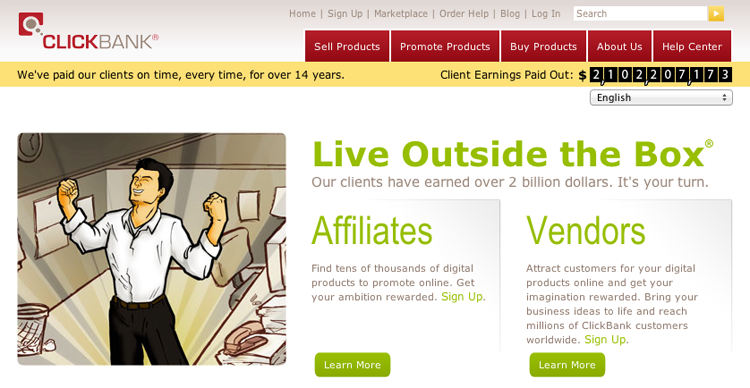
But what does someone in the Vendor audience think of himself as? Maybe he thinks he’s an advertiser or marketer or something else. What about the Affiliate group? Maybe an affiliate thinks of herself as a publisher or a blogger. Even with the best intention for using segmentation, you can inadvertently reduce relevance by using your internal labels for people.
You should test the labels you use for your audience segments and consider carefully whether segmentation enhances or reduces your messages’ relevance. Targeting your segments at the source whenever possible will also minimize labeling risk.
Decision Complication
Your landing pages should minimize decision-making for your prospects. By adding a segmentation decision, you risk confusing and complicating their decision before they have enough motivation. Your prospects may also wonder why they’re being forced to choose a different path than others and will often open both paths to find out whether the other segments receive better offers.
If the messages for each audience aren’t significantly different or justifiable, you’ll get better results by creating a more compelling landing page that applies to all segments.
Call-to-Action Relevance
Are your prospects ready to buy immediately, or do they need to gather more information first? Are they looking for a quote, or do they prefer to collect more data?
Your prospects have expectations for the type of action they want to take next. By testing the types of calls to action to emphasize, you can make dramatic improvements in your results.
Think back to the PowerDirector 10 landing-page experience earlier in this chapter. In addition to losing the scent trail from the banner ad, the landing page assumes too much about the visitor’s motivation level.
Clicking a banner ad indicates a low level of interest—perhaps only curiosity. By confronting the visitor with an immediate “Sell! Sell! Sell!” message, the landing page disconnects from the visitor’s need.
The PowerDirector 10 landing-page experience would have more success if it paid off what the visitor was looking for. For example, it could provide helpful tips for how to use their software to make the perfect movie or emphasize features to support that promise.
At the very least, the landing-page headline should match the ad, even if the rest of the page is an unchangeable template for many products. But it would be well worth the effort to rethink this landing-page experience to create a more relevant solution payoff.
There’s a balance to be struck that provides enough helpful information to keep your prospect engaged, while positioning your product as the solution to your prospect’s needs and giving a strong reason to convert into a lead or customer.
With your ads and landing pages, you should test the spectrum between relevant, helpful content and hard-hitting calls to action to find the balance that maximizes conversions and revenue.
Tone Relevance
Thirteen-year-old girls respond to very different words, images, and design than 45-year-old corporate buyers. Different target audiences tolerate and respond to varying degrees of marketing messages.
In WiderFunnel’s testing, we’ve seen distinct target audience groups, like software developers and data analysts, who have very sensitive marketing detectors and are turned off quickly. A classic example is a test we ran on a trial software-download page for Safe Software. The target audience of GIS professionals rejected one design we created that included some elements that have worked well in other scenarios, such as testimonials, a hero shot, and a curved arrow.
The underperforming page
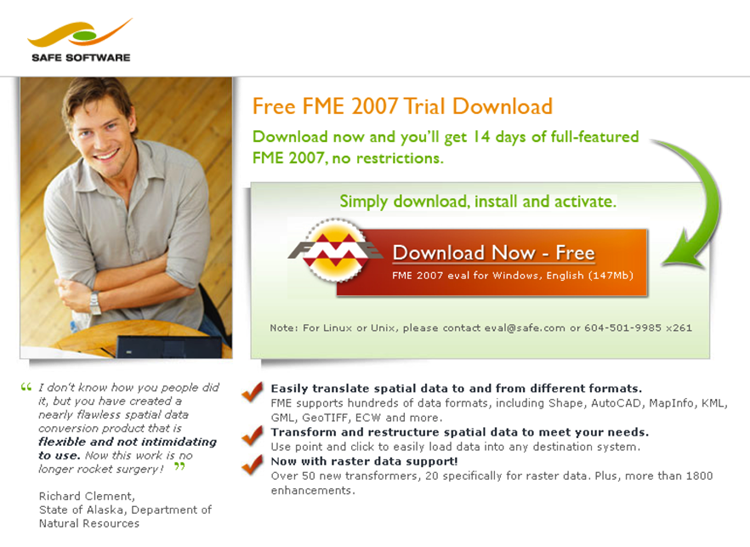
That marketing “best practices” challenger even underperformed the original page. In this case, a minimalist design without elements that set off marketing alarm bells increased trial software downloads by 15.5 percent!
The winning trial software-download page
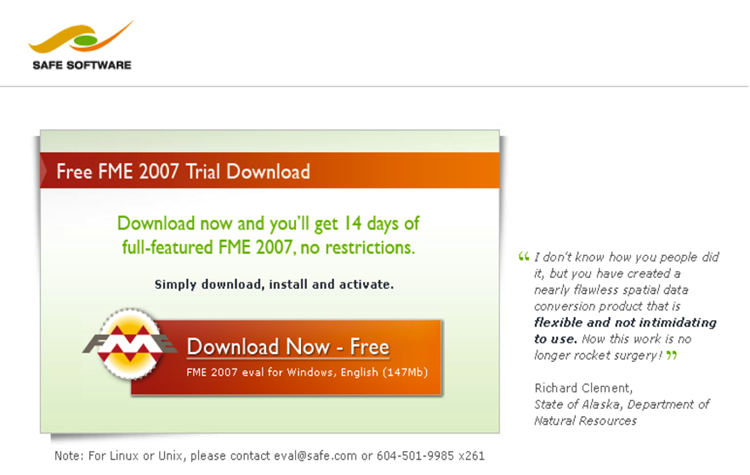
Ralph Waldo Emerson said, “Who you are speaks so loudly, I can’t hear what you’re saying.” Fortunately, with your marketing, you can test how the tone of your message affects your audience. The following case study shows an example of how testing the design tone to appeal to a particular target audience can lead to dramatic improvements in relevance and results.
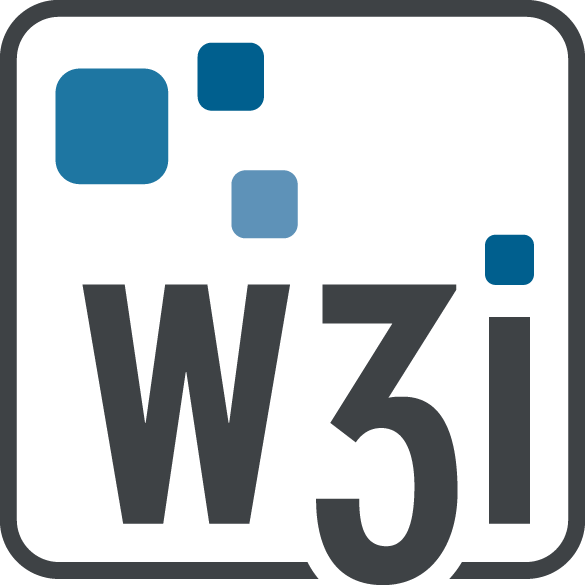
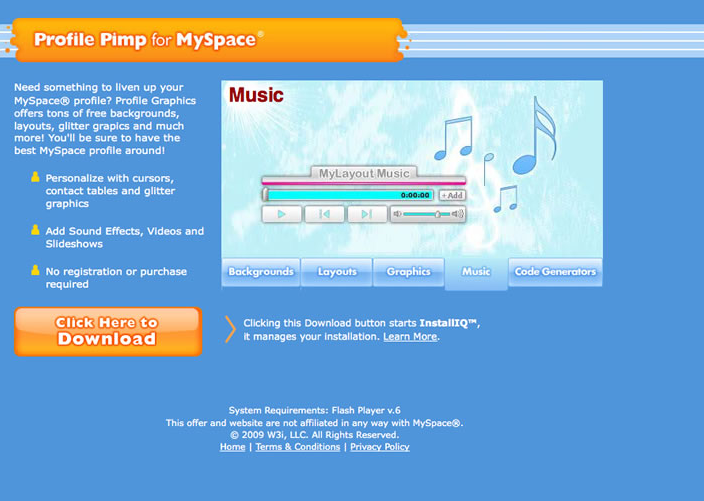
The winning test-page variation
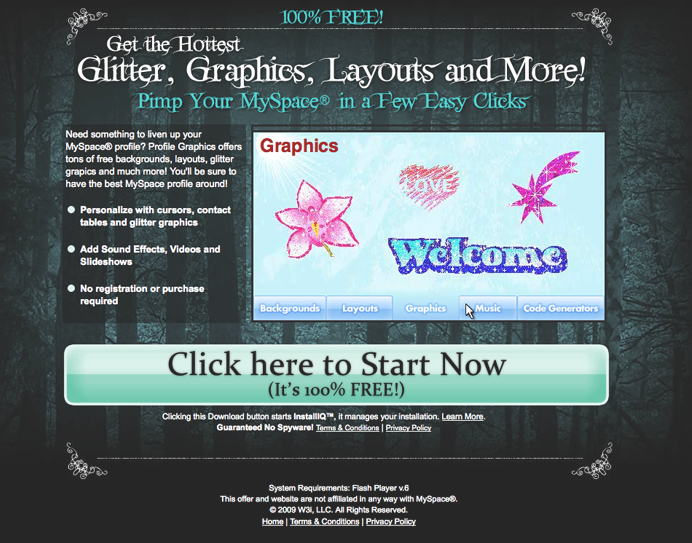
As this case study showed, by understanding your audience, you can create more relevant landing-page experiences that will produce significant lift in results. You can also test different types of experiences to get quantitative knowledge about your visitors’ needs, wants, and interests.
The relevance of your ads and landing pages is just the beginning of the conversion funnel for your prospects. You need to maintain relevance throughout the entire conversion funnel.
Navigation Relevance
Can your prospects intuitively see and find your products and services that meet their needs? Can they locate your products using navigation methods they’re accustomed to? Some of your prospects like to find products using search on websites. Others like to browse through categories. Some look for product names or descriptions in text links. Others click images. Some are deal hunters. Others are spec seekers. Does your website navigation facilitate all styles, or is it oriented toward one preference?
You increase navigation relevance by displaying product and navigation options that get your prospects to their desired products easily and accurately. As an example, Walmart’s mobile site forces visitors to use search alone to find their products. The default navigation includes only the following:
- A daily special (which is out of stock today, at 8:04 a.m.!)
- Sale items (which they call rollbacks)
- Local advertised specials
- Pharmacy refills
- Photo printing
- Order tracking
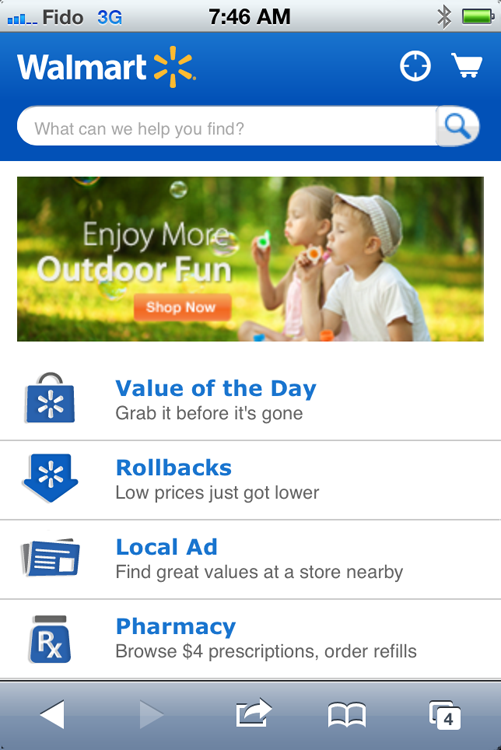
There’s no department list to choose from. This ignores the types of visitors who prefer to browse within departments or product categories rather than using search.
What if I’m looking to browse a product category—say, for summer clothing? First I need to think about a particular type of item I might want: for example, “summer shorts.” The resulting search results page shows one of the limitations of relying on search.
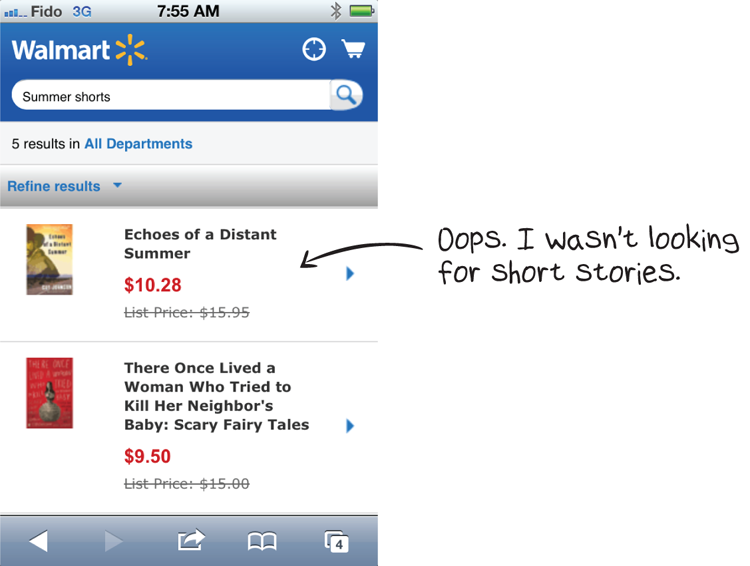
That search term has other meanings that clearly aren’t relevant to my need for beachwear!
Incidentally, Walmart’s desktop site does an excellent job of including departmental navigation and search options.
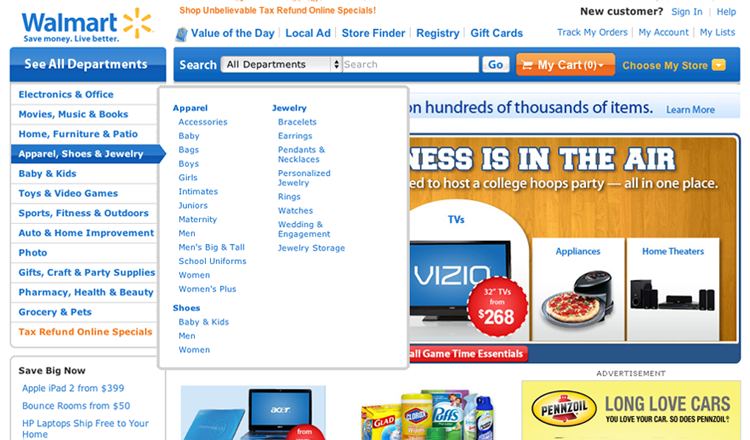
If I navigate to the mobile rollbacks page, it shows a good example of a departmental browsing navigation option.
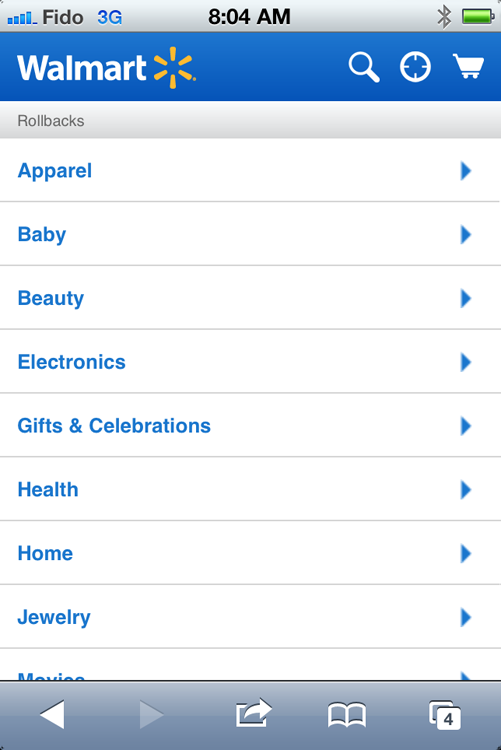
If I were Walmart, I would hire WiderFunnel to test the current mobile home page against new challenger pages. One challenger we could test would facilitate browsing by department as well as search.
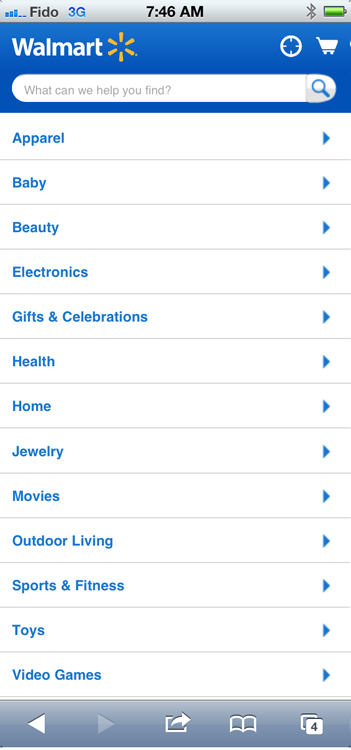
We could also test a hybrid that included specials and offers plus a link to browse by department.
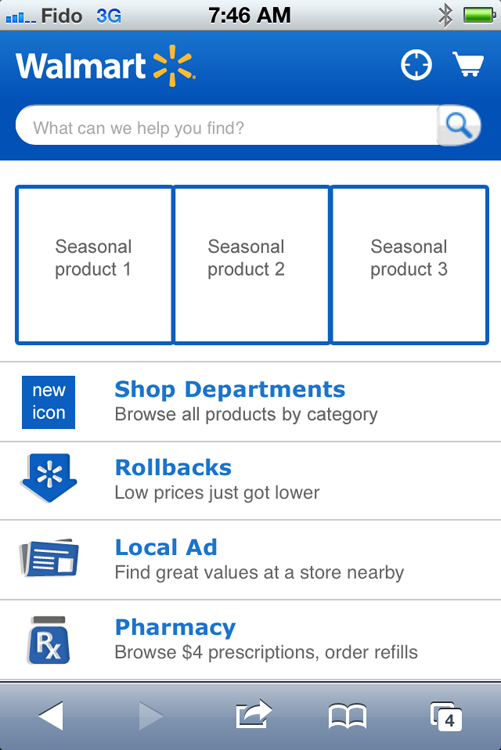
I can think of many more challenger permutations we could test as well! Once you identify a conversion problem, you can imagine an unlimited variety of ways to solve it. By testing many variations and iterations, you can find the optimized page that provides the most relevant navigation experience for your prospects.
The following case study details a test in which WiderFunnel created dramatically different variations of navigation and product-merchandising options, with significant lift in e-commerce sales as a result.

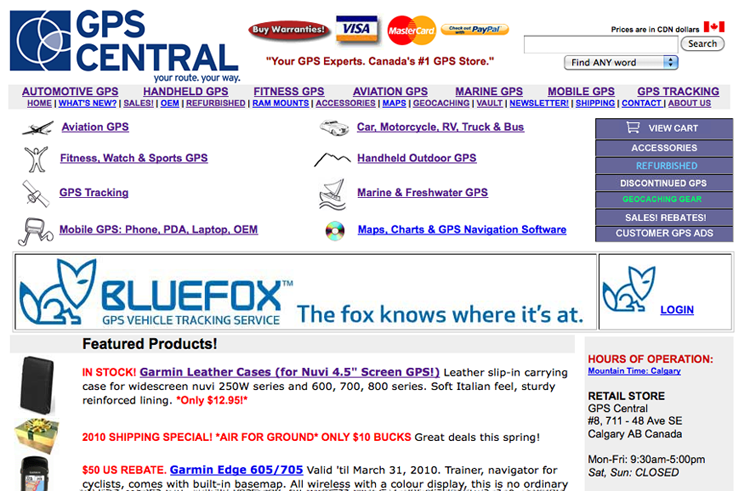
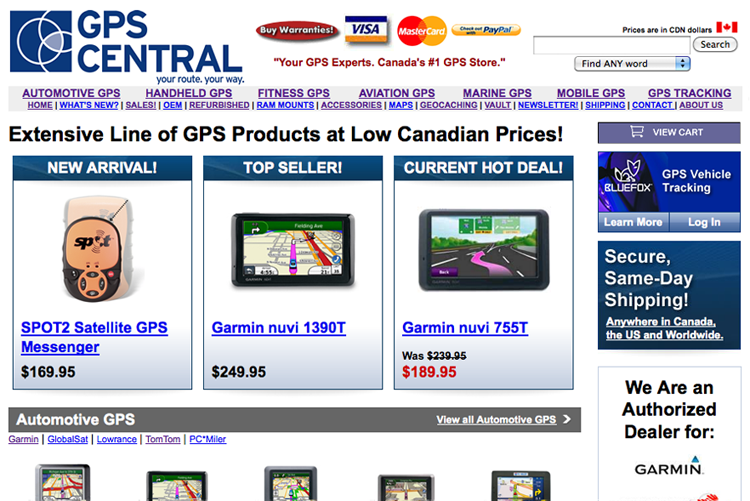

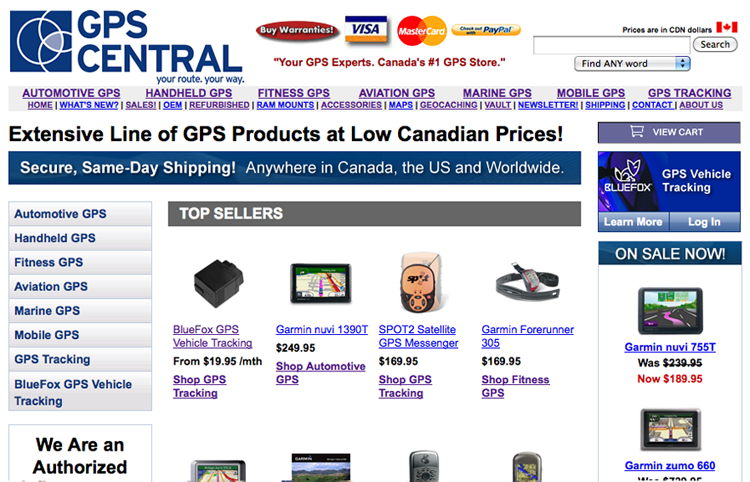
As you can see, by testing to improve the relevance of your marketing for your audience, you can make a huge difference in conversion rates.
The final factor this chapter considers is relevance to your competitive environment.
Competitive Relevance
How does your value proposition stack up against competitors? If you’re like most companies, you create your ads and landing pages by comparing several options beside each other. You may lay them out on a boardroom table to choose the creative option that is most appealing.
But do you lay out your creative beside your competitors’ ads too? Do you modify your messages based on competitive activity?
Your competitors’ value proposition and messages impact your conversion rates directly and should be considered in your planning process. Take a look at a search for “trademark lawyer” as an example. These two ads show significantly different pricing.

The first landing page, for TrademarkAttorneys.com, needs to work hard to justify its 4× price difference over The Trademark Company. It needs to add a lot more value proposition to give a compelling reason why its service is worth the price. The company’s landing page falls short, though.
The second landing page, for The Trademark Company, is far from perfect, but at least it maintains the scent trail with the price in the headline. And with a price that’s 25 percent of the competition’s, the company has a strong head start on building its value proposition.

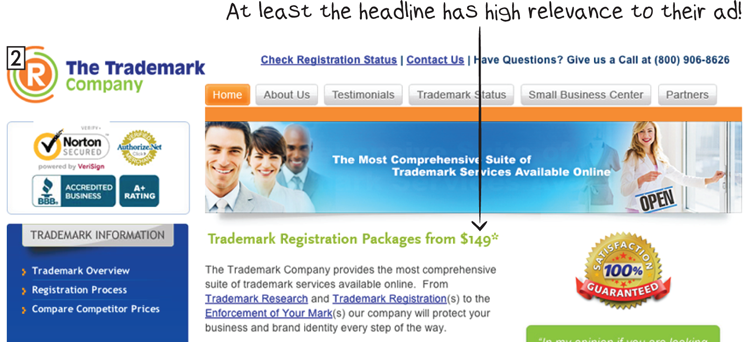
As important as price is, it’s not the only aspect of your competition to consider. As part of a competitive review, you should consider all aspects of your competitive environment and look for opportunities to test new positioning for your offering against your competitive set.
In Chapter 7, “Optimize for Clarity,” you’ll see how to move beyond relevance to test and maximize the clarity of your value proposition, including clarity of your page’s design, call to action, and copywriting.
